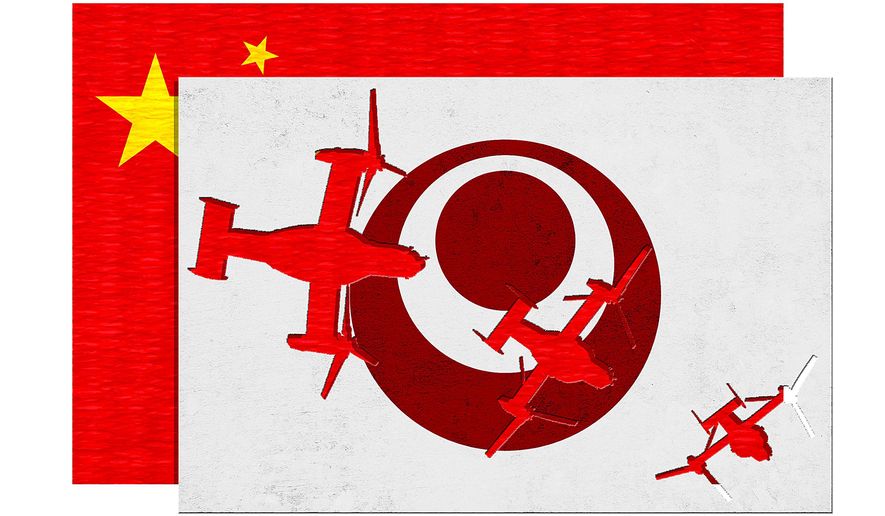OPINION:
The governor of Okinawa Prefecture, Japan, Takeshi Onaga, is amid a visit to Washington, D.C., the latest in a number of governors over the years to travel to the United States to “appeal” issues surrounding our base presence.
These journeys began in the early 1950s, but became much more frequent in the 1990s when a leftist governor at the time, Masahide Ota, who had studied at Syracuse University under an American government scholarship, felt the U.S. government would be more sympathetic to Okinawa’s demands regarding the presence of our bases than his own central government, which he once described in the title of a book as “The Ugly Japanese.”
Mr. Onaga, a four-term mayor of Naha, the prefecture’s largest city, was elected governor in November 2014 as the result of a sophisticated campaign amid a highly divided and complicated election. Although formerly a conservative and once rising star of the ruling Liberal Democratic Party (LDP) in Okinawa, even running his opponent’s re-election campaign in 2010, he broke with his predecessor and chose to run on an anti-base platform dominated by the organizational might of the Communist Party, the archenemy of the conservative LDP.
In order to hide the influence of the extreme left, the campaign was described as a united front, an “All Okinawa” one, although that is far from the case as Okinawan public opinion is very much divided. This is not the only misunderstanding the anti-base forces in Okinawa like to use. Beginning last year, they have labeled the planned construction of the Futenma Replacement Facility at Camp Schwab, where protests have picked up in recent months, as a “new base,” when, in fact, it is not.
The Marine Corps base has been there for nearly 60 years, and will be absorbing the relocation of the functions of Marine Corps Air Station (MCAS) Futenma through the construction of a runway and apron area, as well as a number of new buildings and facilities. It is a massive project (and one, frankly, that was not well thought-out), but it is not a “new base.”
There are many other fictions created by these activists, who work hand-in-hand with the local media, national and international “peace” groups and politicians, and whose base (no pun intended) are these very anti-base forces. Examples are the description of MCAS Futenma as the “most dangerous airfield in the world,” and the MV-22B Osprey as the most dangerous aircraft in the world, when facts show otherwise. Similarly, one of Mr. Onaga’s popular claims is that all the land for the base construction in the postwar period was seized from Okinawans (not true), and that the bases today contribute little to the economy and are an impediment to economic development (also not true). Similarly false is the accusation that U.S. service members and their dependents have a high crime rate in Japan, and that there are no legal remedies for Japanese citizens who have been victimized.
Like crime statistics and economic figures, percentages of land usage are similarly misleading and used to great effect by critics and pundits alike, particularly those within the Capital Beltway. Not captured in any of these numbers are the alternate explanations behind them. In fact, the expression, “there are two sides to every story” is never truer than in the case of Okinawa.
A rally was held on May 17 in a new baseball stadium built in Naha (80 percent of the construction costs covered by the central government), with 35,000 reportedly attending, to protest the construction at Camp Schwab. In fact, not only was this number low by previous standards, but the actual numbers were approximately half that. Photos comparing the rally with a Major League Baseball all-star game held there show that the baseball game, with 17,900 spectators, had many more in attendance. Rally participants were double- and triple-counted because they belong to multiple organizations that were present. Indeed, many of the participants were from outside the prefecture — professional agitators and mobilized union members. They were forbidden from flying their organizations’ banners, as their actual hometowns would have become known.
This is certainly not an “all Okinawa” movement by any means. When all the rhetoric is stripped aside, Mr. Onaga really has nothing left to say. Many Okinawans already know this and are angry with him and his delegation for even taking the U.S. trip at taxpayer expense.
There is more than meets the eye regarding Okinawa. Washington, especially those in the media and think tank world, mustn’t be fooled any longer. Okinawa is too important geostrategically for the United States, Japan and the entire Asia-Pacific region to become, as Mr. Onaga urges, “a peaceful buffer zone with no bases.”
Americans shouldn’t be afraid to challenge his factually incorrect and sometimes emotional rhetoric, and to be more proactive and positive in their public affairs and community relations outreach. In the absence of such a public diplomacy vacuum — a sad trend over the past couple of years — only the haters (and China) can win. As an honorary citizen since 2005 of Naha’s sister city in China, Fuzhou, Mr. Onaga has been groomed for a long time by Chinese leaders — the same ones who declared earlier this week that war with the United States is “inevitable.”
• Robert D. Eldridge is the author of “The Origins of the Bilateral Okinawa Problem” (Routledge, 2001), and was deputy director for government and external affairs for Marine Corps Installations Command-Pacific, in Okinawa, from 2009 to 2015.




Please read our comment policy before commenting.